Managing a project means working with multiple stakeholders who have their own priorities, levels of influence, and expectations. Navigating this web of people to involve and knowing the right amount of information to share can be tricky without a proper framework.
In this article, we’ll cover how a stakeholder matrix can help you prioritize and engage the right stakeholders at the right time. You’ll learn how to map stakeholders based on their influence and interest and how to build a matrix from scratch.
What is a stakeholder matrix?
A stakeholder matrix is a visual tool that helps you organize and analyze your stakeholders based on their level of influence and interest in a project.
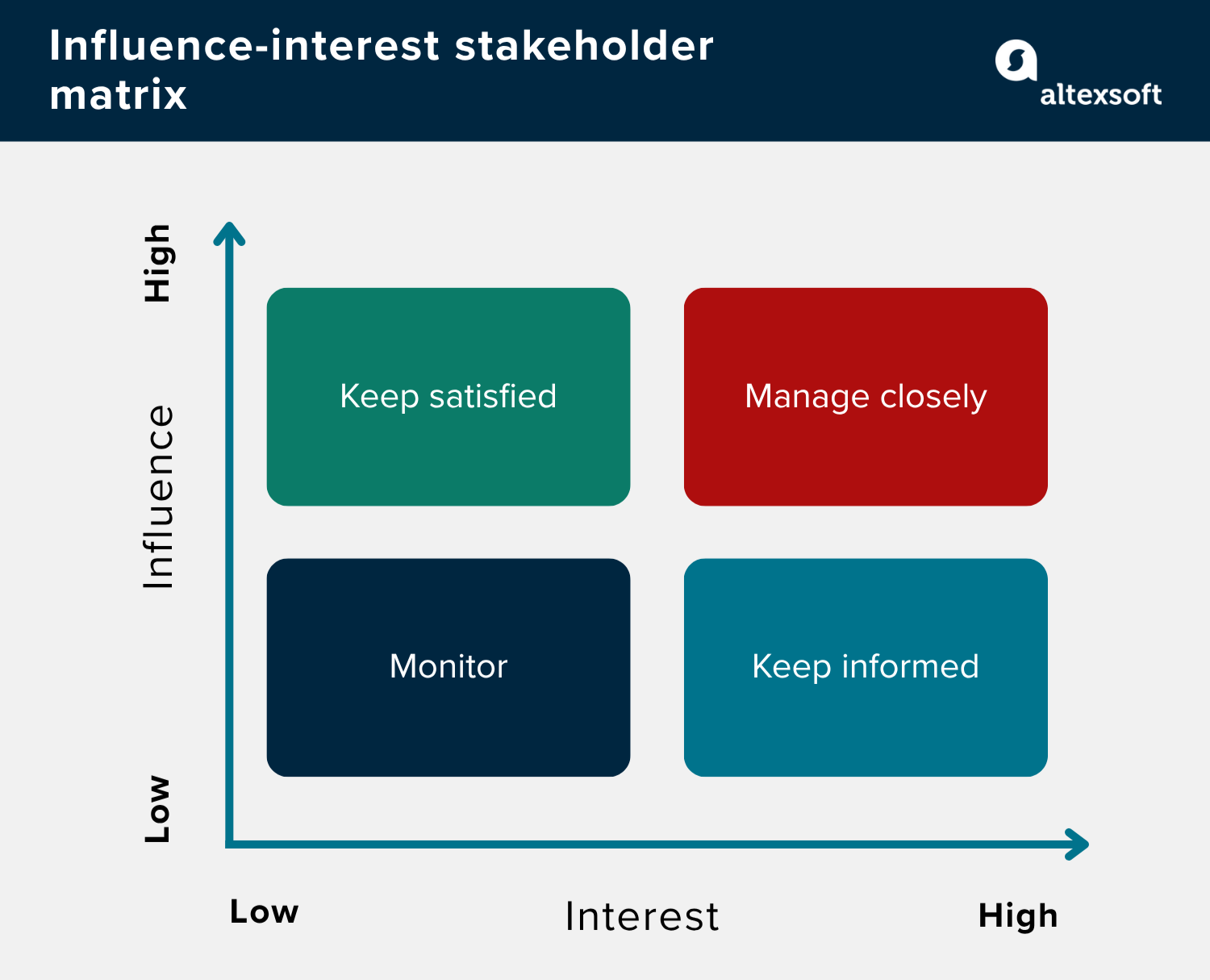
It gives you a clear picture of who has the most impact, who requires regular communication, and who only needs occasional updates. The idea is to place stakeholders into four groups: manage closely, keep satisfied, keep informed, and monitor.
With the matrix, you can focus your time and effort where it matters most. It helps ensure that you’re neither under- nor over-engaging with any person or group throughout the project lifecycle.
Key components of a stakeholder matrix
The stakeholder matrix is represented as a two-by-two grid. It has a few core elements that make it effective and easy to use. These components help you understand how to position each stakeholder and decide the level of attention they need. Over time, you can update the grid as new stakeholders come or priorities shift.
Influence
There are different models you can use when creating a stakeholder matrix—we’ll explore them later. Depending on the one you choose, influence can also mean power or impact, or they can be separated into distinct dimensions to capture different aspects of a stakeholder’s role.
In a standard matrix, which we’ll use as the baseline, influence, power, and impact are treated as the same thing, reflecting how much control a stakeholder has over the project’s direction or outcomes. This could mean the authority to approve budgets, set priorities, change timelines, or influence leadership opinions.
For example, when building an MVP on a tight schedule, a product manager may decide which features make it into the first release and which can wait. In this instance, the product manager has high influence because their decisions directly shape the project’s trajectory.
There are also roles that, though vital, have lower influence. A quality assurance specialist, for instance, helps improve a product’s quality, but typically doesn't determine a project’s strategic direction.


Interest
Interest measures how much a stakeholder cares about or is affected by the project’s results. High-interest stakeholders, like end users who will use the final product and clients expecting deliverables, are directly involved and want regular updates and progress reports. Low-interest stakeholders, such as finance or legal teams who review documents occasionally and executive sponsors who only want milestone updates, might only need to know the final outcome or major changes.
Knowing collaborators‘ level of interest is important for balanced communication. This way, you don’t overload people who only need the highlights, and you don’t leave out those who expect to be kept in the loop.
Stakeholder categories and engagement strategies
Once you’ve assessed influence and interest, the next step is to group stakeholders into four categories. Note that these categories aren’t fixed because they depend on the type of project you’re managing.
In one project, a department head might have high influence, while in another, they might not. Still, some roles tend to fall into certain groups more often than others.
Manage closely (high influence, high interest). These are your core stakeholders, the people who shape the project and care highly about its success. They might include sponsors, senior executives, or key clients. In product teams, that could be a product owner or lead developer.
You’ll need to involve them in major decisions and keep them closely updated. Regular one-on-one check-ins, milestone reviews, or shared dashboards work well here. They expect to see all progress, challenges, and decisions in real time.
Keep satisfied (high influence, low interest). This group has the authority to affect your project, but doesn’t need to know every detail. Examples include senior leadership or department heads who oversee several projects at once. Their main concern is that your project is aligned with business goals.
They don’t want a weekly status email; They want to know if the project is on track and if there’s anything that needs their attention. Give them concise updates that highlight key results, potential risks, or resources you need.
Keep informed (low influence, high interest). They are people who care about the project but have little or no decision-making power. These could be end users, customer support teams, or internal staff who will work with the final product. While they don’t shape strategy or determine a project’s roadmap, they’re affected by its outcomes.
In this case, communication is about inclusion, sharing progress updates, explaining changes, and asking for input when it matters. For instance, if you’re building an internal tool, keeping employees informed makes company-wide adoption easier after the product launch. The employees don’t influence deadlines or budgets, but if they’re left out, it could lead to lower adoption.
Monitor (low influence, low interest). This group doesn’t have much stake in day-to-day work, but ignoring them completely can still cause problems. External vendors and peripheral departments fall under this category. For example, if a software rollout might change how invoices are processed, the finance support team should know ahead of time. The goal isn’t to involve them deeply but to keep them aware of things that affect their work.
Sometimes this group becomes more important as the project evolves. A compliance officer who started as a low-interest stakeholder might become critical when your project enters review. That’s why it helps to revisit your matrix regularly.
Types of stakeholder matrix
While this influence–interest layout is the most common, it’s not the only one. Some matrices use different dimensions—such as power, impact, or urgency—depending on what aspect of stakeholder dynamics you want to analyze. These variations form the different types of stakeholder matrices.
Power–influence matrix
The power–influence matrix is a variation of the standard stakeholder matrix. Instead of treating influence and power as the same, this matrix looks at power as formal authority—the ability to make decisions, approve budgets, or set priorities—and influence as the informal ability to sway opinions, shape decisions, or guide the team through expertise or relationships.
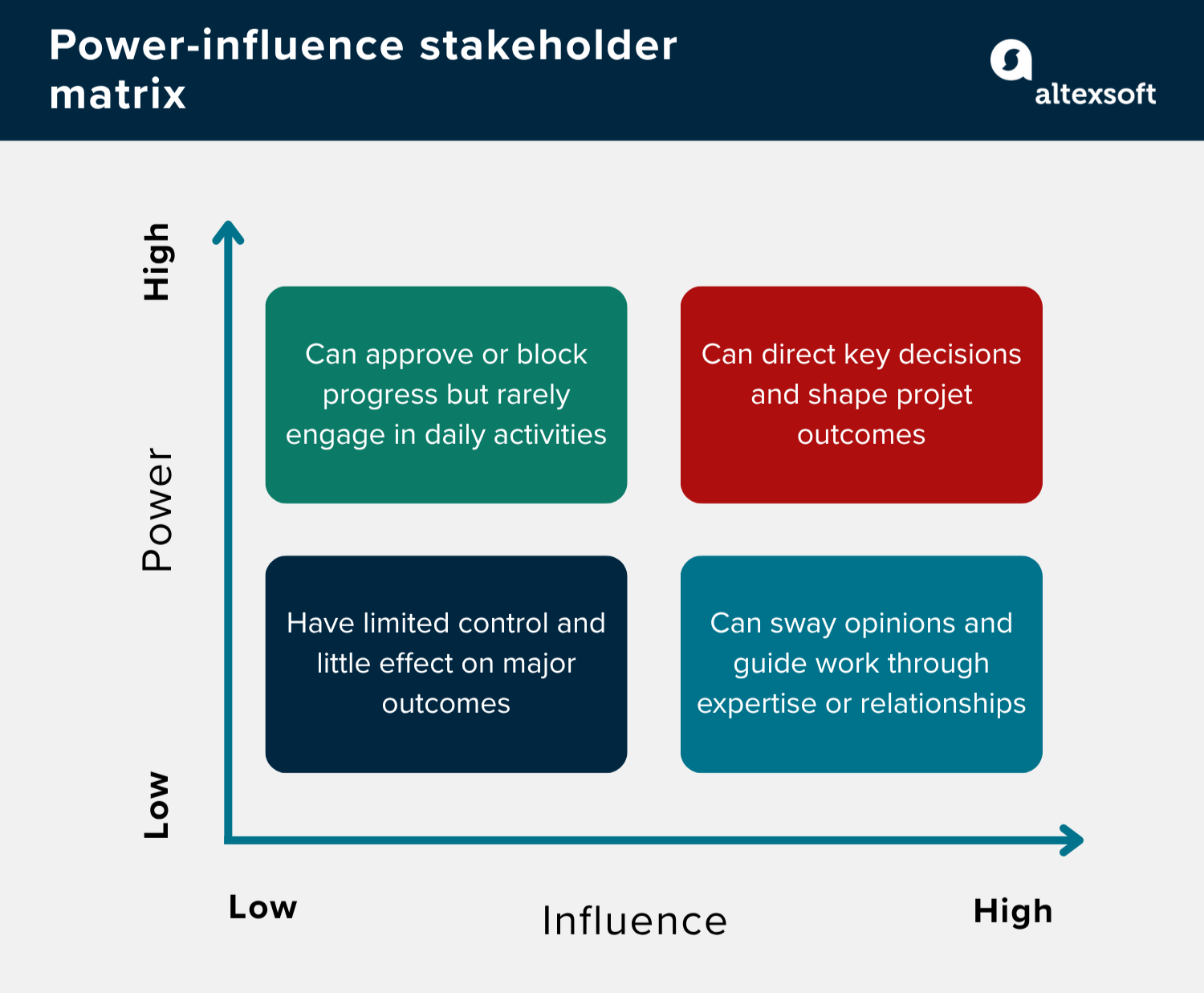
This matrix allows you to see who has formal control and who can affect outcomes through persuasion, reputation, or knowledge. For example, a project sponsor may have high power but low day-to-day influence, while a senior software engineer might have high influence because the team relies on their expertise, even if they don’t approve budgets or timelines. This type of matrix helps you identify these subtle, nuanced dynamics early.
Influence–impact matrix
The influence–impact matrix focuses on two dimensions: influence—which we’ve covered—and impact, which reflects how much the project’s outcome affects the stakeholder. This type of matrix is particularly useful in projects where stakeholders may not have formal authority but could be significantly affected by changes, such as regulatory bodies, end users, or external partners.
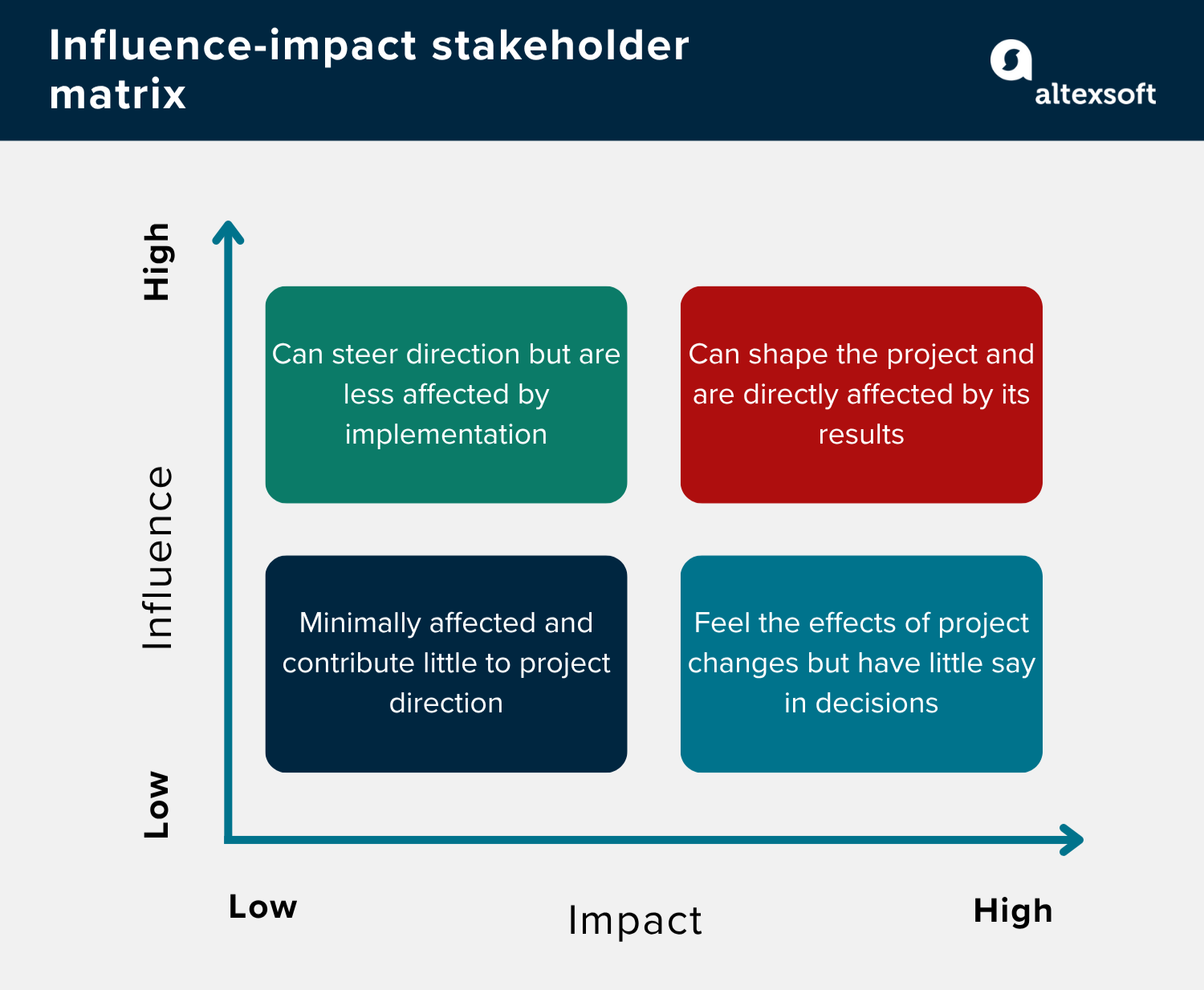
For example, in a software rollout, a customer support team may have little influence over decisions but will experience a high impact because they will manage user questions and issues once the system goes live. On the other hand, a sponsor may have high influence but low personal impact if they are removed from day-to-day operations.
Impact–interest matrix
The impact–interest matrix maps stakeholders based on how much the project affects them (impact) and how concerned or invested they are in the project (interest). It’s commonly used in the public sector, policy, or community-based projects where the final product touches a broad range of people.
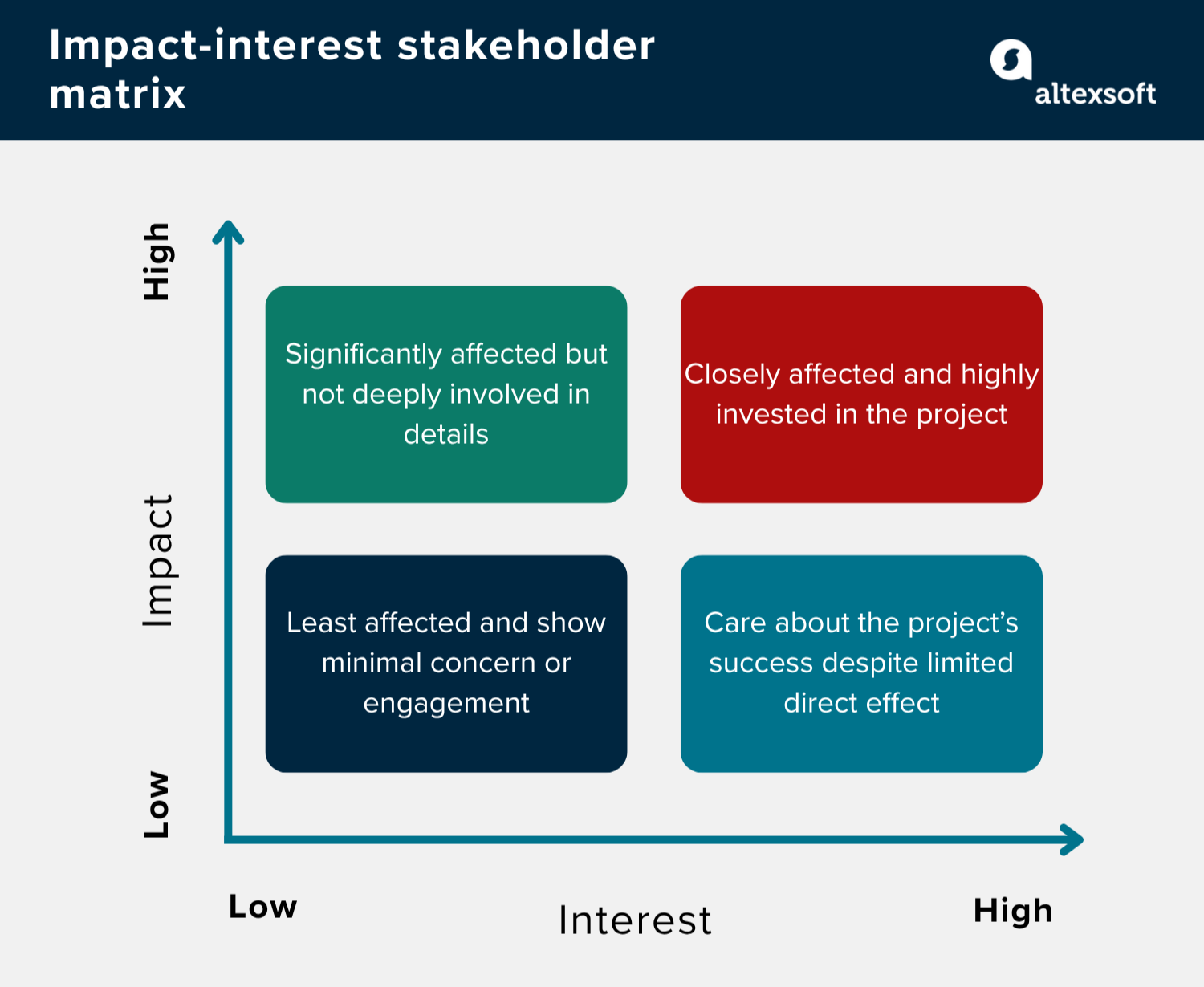
For example, in a company-wide software rollout, employees who will use the new system daily have a high impact and high interest because it directly changes how they do their work. On the other hand, senior executives might have low impact on day-to-day usage but high interest in ensuring the system supports the business’s goals and delivers the needed benefits.
Salience model
The salience model is a more advanced form of stakeholder analysis. Instead of using two dimensions, it relies on a Venn diagram with three components: power, legitimacy, and urgency. In this model, power refers to the stakeholder's ability to influence the project, legitimacy indicates whether the stakeholder has a valid, recognized stake in the project, and urgency reflects how immediate or time-sensitive their needs or concerns are.
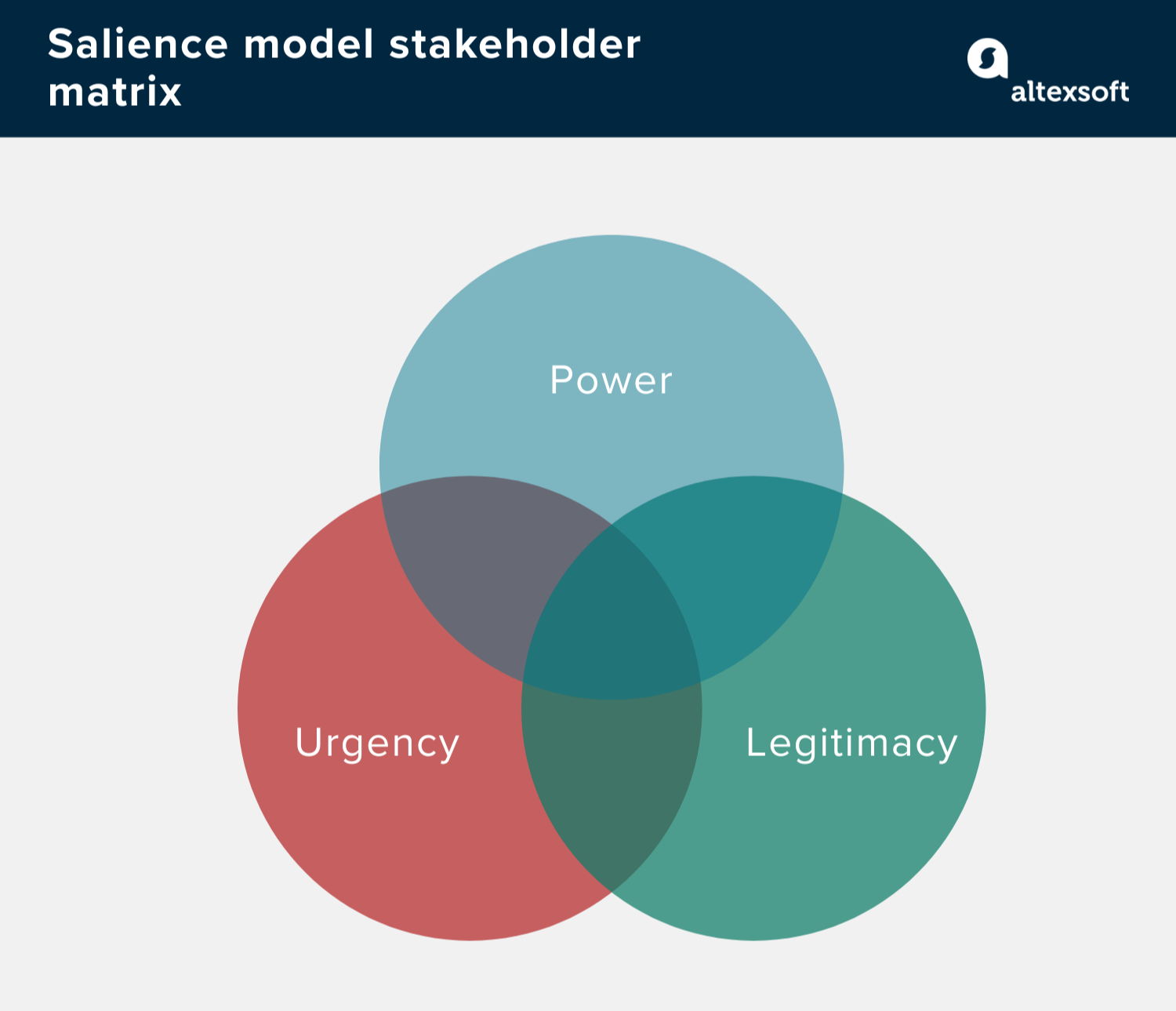
This model helps prioritize stakeholders when many people compete for attention or when timing is critical. Those with all three attributes are considered the most critical and should receive priority in engagement. A project sponsor raising a time-sensitive compliance issue would have high salience, while a peripheral department with no pressing concerns might have low salience.
How to build a stakeholder matrix
Building a stakeholder matrix is not just about drawing boxes on a grid or circles on a chart. The following steps can help you move from a list of names to a clear visual map that shows who matters most and how to manage them.
1. Identify your stakeholders
Start by listing everyone involved or affected by the project. Think broadly—project sponsors, team members, clients, end users, suppliers, and even departments that might feel the project’s ripple effects. Your list doesn’t have to be perfect the first time. You can always revisit and update it as the project evolves and new players emerge.
2. Choose a stakeholder matrix and analyze accordingly
Once you have your list, the next step is to decide which type of stakeholder matrix best fits your project. For this case, we’ll use the influence–interest matrix, since it’s the most common and practical for most project types.
3. Categorize stakeholders
Now that you’ve analyzed each stakeholder, group them into the four classic categories:
- Manage closely (high power, high interest)
- Keep satisfied (high power, low interest)
- Keep informed (low power, high interest)
- Monitor (low power, low interest
There are various tools you can use to create this visual map, including Canva, Miro, Lucidspark, and spreadsheet software.
4. Develop an engagement strategy
Once you know where everyone fits, plan how to engage them. This involves defining how often you’ll communicate with each group, what information they’ll receive, and through which channels—whether that’s meetings, emails, dashboards, or reports. The goal is to use your time and resources wisely while keeping everyone appropriately informed.
5. Review and update regularly
A stakeholder matrix isn’t static. As your project moves forward, priorities shift, new stakeholders appear, and existing ones may gain or lose influence. For example, a department that played a minor role during the planning phase might become more critical during implementation, or a new sponsor could step in with different expectations.
Make it a habit to revisit your matrix at key stages—after major milestones, scope changes, or leadership transitions—to keep your engagement strategy current and effective.

With a software engineering background, Nefe demystifies technology-specific topics—such as web development, cloud computing, and data science—for readers of all levels.
Want to write an article for our blog? Read our requirements and guidelines to become a contributor.

